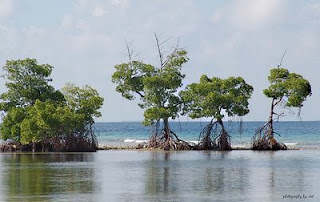-
This Mangrove Forest Could Save Your Life: Protected Areas and Disaster Mitigation
June 16, 2008 By Sonia Schmanski Natural disasters “are not ‘natural’ at all but are the consequence of our scant regard for the ecosystem services our natural environment provides,” write the authors of “Natural Security: Protected areas and hazard mitigation,” fifth in the Arguments for Protection series published jointly by the World Wildlife Fund and Equilibrium.
Natural disasters “are not ‘natural’ at all but are the consequence of our scant regard for the ecosystem services our natural environment provides,” write the authors of “Natural Security: Protected areas and hazard mitigation,” fifth in the Arguments for Protection series published jointly by the World Wildlife Fund and Equilibrium.Authors Sue Stolton, Nigel Dudley, and Jonathan Randall argue that “investment in a well-managed, ecologically representative, global system of protected areas can produce benefits far beyond the conservation of biodiversity.” They find that protected areas can prevent natural hazards from turning into natural disasters in three ways:
- Natural ecosystems such as coastal mangroves, coral reefs, forests, and floodplains can serve as buffers against tsunamis and hurricanes;
- Traditional ecosystems such as terraced crop-growing, agroforestry systems, and fruit tree forests can protect arid lands; and
- Protected areas can restore ecosystems that have been damaged by natural hazards.
Regrettably, “the under protection of some biomes [such as coastal mangrove forests]…and the exploitation rather than the conservation of forests and wetlands has left many areas extremely vulnerable to disaster,” write Stolton and colleagues. These environmental consequences are driven by numerous forces, one of which is population growth. “Around the world,” they write, “the pressures of poverty, population growth and inequitable land rights are forcing people to live or produce food in the most vulnerable areas.”
This unfortunate reality, though, could be greatly improved by relatively small investments. For example, a $1.1 million investment in mangrove forests in Vietnam saved the country $7.3 million in sea dike maintenance and protected villages from the devastation of Typhoon Wukong in 2000. Protected areas are also important in the developed world. For more than 150 years, the Swiss government has used reforestation programs to reduce the risk of avalanches, flooding, and landslides in the Alps. Aside from protecting the land and people of the region, it is estimated that these forests add between two and three billion dollars per year to the Swiss economy, for the most part through revenue from the tourism industry in the region.
These examples demonstrate that the world needs more—and better—protected areas, particularly in ecologically vulnerable regions. Sadly, preventive measures often take a back seat to responses, when in fact, they could make such responses unnecessary.
Photo used courtesy Flickr user jawiyani.
 A Publication of the Stimson Center.
A Publication of the Stimson Center.

 Natural disasters “are not ‘natural’ at all but are the consequence of our scant regard for the ecosystem services our natural environment provides,” write the authors of “
Natural disasters “are not ‘natural’ at all but are the consequence of our scant regard for the ecosystem services our natural environment provides,” write the authors of “

